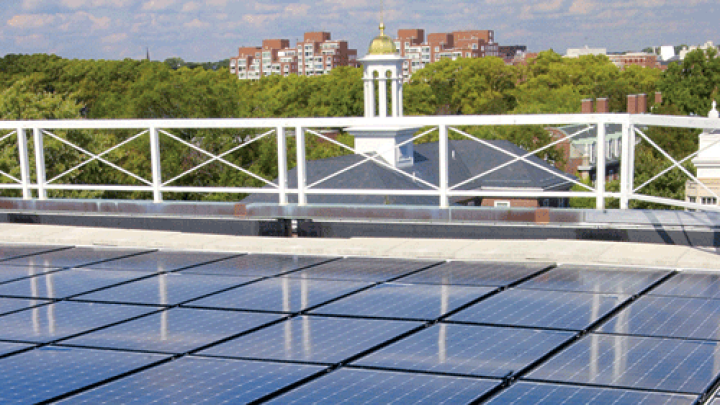The University will cut its greenhouse-gas emissions by 30 percent during the next eight years, President Drew Faust vowed in a July 8 announcement.
Harvard had already committed to ambitious environmental goals for the new Allston campus (see “Growing Green,” November-December 2007, page 28E), but this was the first University-wide greenhouse-gas emissions pledge. In making it, Faust endorsed the recommendations of a task force (chaired by Brooks professor of international science, public policy, and human development William C. Clark) that she appointed in February to consider the issue. Using the University’s 2006 emissions—282,000 metric tons of carbon dioxide equivalent (MTCDE)—as a baseline, a 30 percent reduction would mean bringing emissions below 200,000 MTCDEs by 2016, even as Harvard expands significantly in size.
By some judgments, even this goal falls far short: the Canadian province of British Columbia is requiring publicly funded colleges there to be carbon neutral—with zero net emissions—by 2010. But even a 30 percent reduction, Faust said, will require “extraordinary efforts”—and conservation won’t suffice on its own. The task force concluded that the University will also need to invest in “high-quality carbon offsets” to achieve its goal. Given the difficulty of ascertaining offsets’ legitimacy and reliability in the current market, the authors said, Harvard would be wise to look into creating its own—by investing in a wind farm, to give one example. This, Faust said, is where the University might make its greatest contribution to combating climate change.
But conservation is the initiative’s cornerstone nonetheless. “We can do all the renewable-energy production we want, but if we are wasting the energy we’re using, we’re actually not solving the problem at all,” says Thomas E. Vautin, the University’s associate vice president for facilities and environmental services, and vice chair of the greenhouse-gases task force. Because Harvard’s properties vary so widely in their energy needs and conservation options, the first step will be a building-by-building energy audit. Still, a few types of solutions are likely to apply to many buildings, and go far to conserve energy. These include making lighting- and temperature-control systems more efficient and trimming energy use during off-peak hours (for instance, by programming lights and computers to turn off when no one is around).

Photograph by Jon Chase / Harvard News Office
Recycling cardboard at the dining hall that serves Dunster and Mather Houses.

Photograph by Jon Chase / Harvard News Office
Washing a car with rainwater that was recycled rather than lost as runoff.
To meet the 2016 goal, Harvard should earmark $10 million to $20 million a year for energy offsets and conservation measures, according to the task force report (see http://news.harvard.edu/gazette/wp-content/uploads/2008/07/GHG_TF_finalreport.pdf). And Vautin is “quite certain” that the University will need to increase its technical staff in this area, either within central administration, at certain schools, or under the auspices of the Harvard Green Campus Initiative (www.greencampus.harvard.edu), which he co-chairs.
Other schools have made similar commitments. Notably, Yale announced in 2005 that it would aim to cut emissions to 10 percent below its 1990 level—or 43 percent below the 2005 level—by 2020. Yale started with emissions nearly as high as Harvard’s, even though Harvard has 20,000 students to Yale’s 12,000, but Harvard’s calculations do not include hospitals (the University does not own any), whereas Yale-New Haven Hospital factors into that university’s calculation. In a new Princeton Review ranking of colleges on “green” criteria, both schools made the 11-member “honor roll.”
Analysis and goal-setting thus far have focused on so-called Scope 1 and 2 emissions: respectively, emissions Harvard produces directly (for instance, from a University-owned truck or power plant) and emissions produced indirectly as a result of energy Harvard purchases (for instance, by an electricity supplier). Not included in the present calculations are Scope 3 emissions—mainly those generated during business travel and employees’ commutes to work.
Faust called the current target “an initial short-term goal” and said the University would set new goals on a rolling basis, with annual assessments and more intensive four-year reviews: “We live in a context in which energy costs, available technologies, regulatory requirements, and broader economic realities are shifting so rapidly that predicting the future is difficult and establishing fixed goals becomes challenging.”








